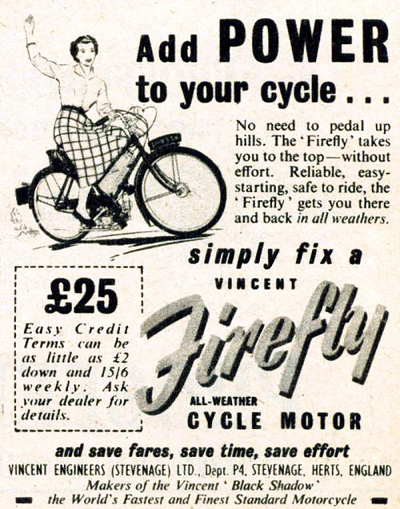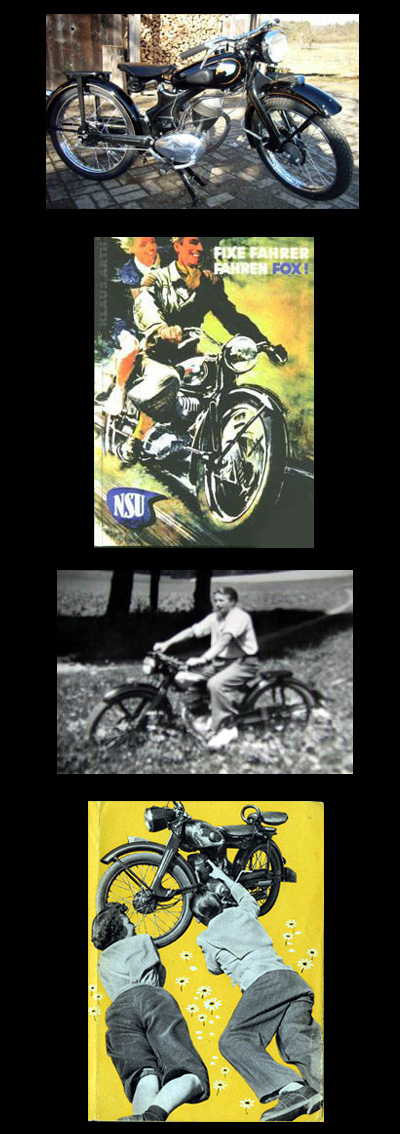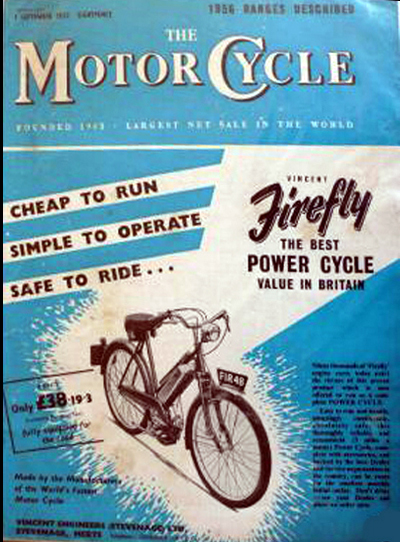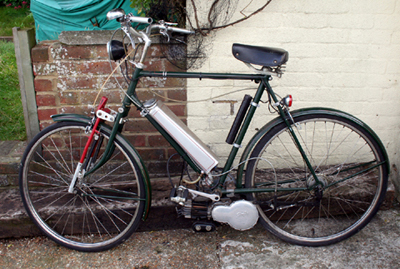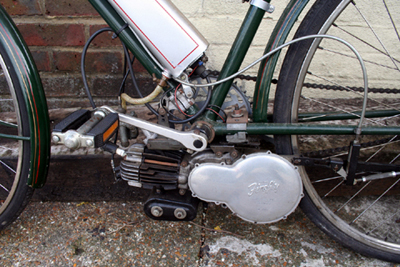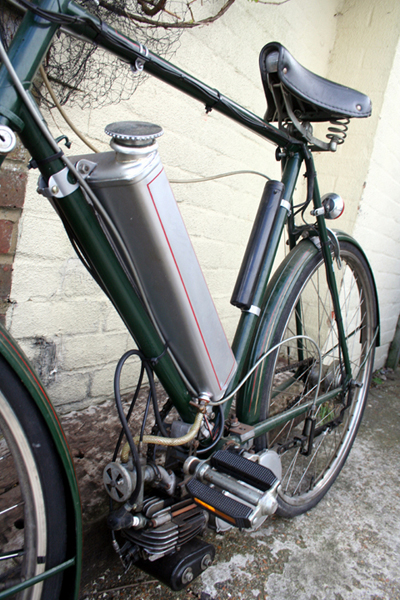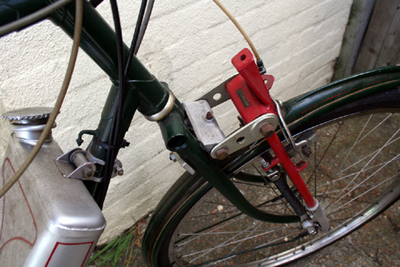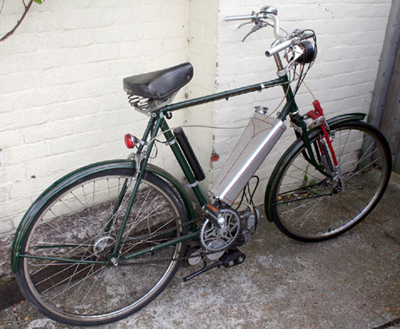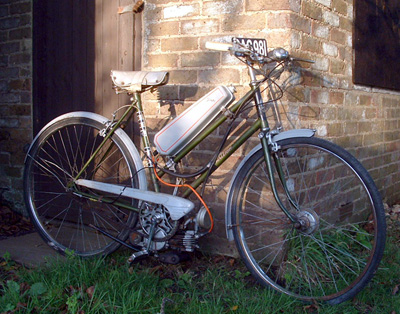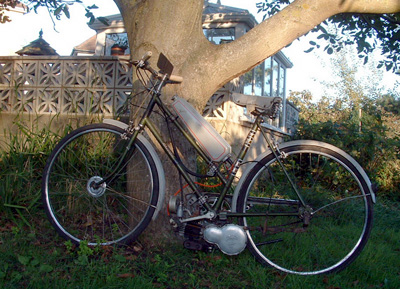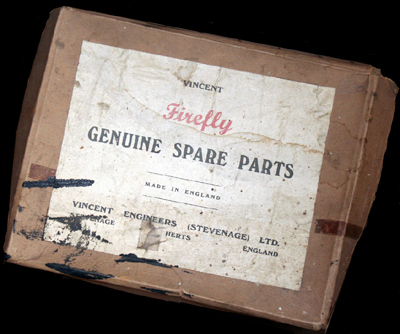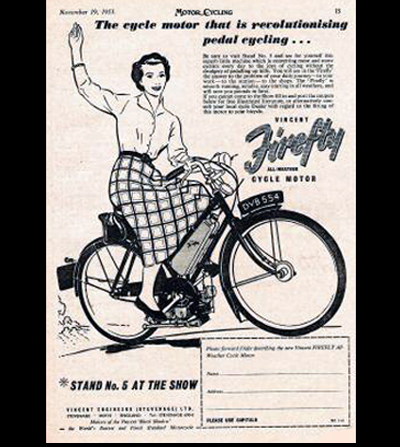PAGE 14. Vincent Firefly
The Vincent Firefly 1953-1956
The post-war market was not easy for Britain’s motorcycle manufacturers. Throughout Europe, most companies were focusing on small affordable machines to help ordinary people get back on their feet.
Vincent, however, made hand-built motorcycles that were exclusive and expensive. This was a big problem. Only 11,000 of their superb machines were sold between 1945 and 1954. The company had to try different ideas to revive their fortunes. In 1954, they built NSU Fox motorcycles and NSU Quicklys under license for sale in Great Britain.
NSU had introduced the Fox in 1949, as the ‘Fox 4 101 OSB’ with a new post-war design and 98cc ohv engine. In 1951 The ‘Fox 2’ was added; it was a Fox 4 with a new 123cc 2-stroke engine. The Vincent-Fox was the Fox 2 model with the 123cc 2-stroke motor. The Fox went on sale in Britain in 1955, but the timing was not good for launching a lightweight motorcycle. The market in 1955 was dominated by the latest motoring marvel – the ‘mo-ped.’ Only 40 were built.
As you may have already read on PAGE 10 of the Cyclemaster Museum, the NSU Quickly was so well-made it totally dominated the moped market. In the first year on sale in Britiain 20,000 Quicklys were sold. However, unfortunately for Vincent, because of this success NSU took over marketing the Quickly a year later.
Vincent even tried out a 3-wheeler sportscar version of their pre-war Vincent Bantam 3-wheeler (1932-1936); they did not get beyond the prototype stage because, at £500 when it was introduced in 1955, the ‘Vincent 3-Wheeler’ (below) was simply too expensive and did not sell.
IN 1955, it was announced that motorcycle production would cease, and the company went into receivership in 1959.
It is against this background that the little Vincent Firefly came on the market.
It is unfortunate that the Firefly symbolizes such troubled times at one of the world’s finest motorcycle companies. But, if that 1950s downturn in the market for prestigious motorcycles had not affected Vincent so adversely, we would not have had such a delightful cycle-attachment engine as the Vincent Firefly.
*************************************************************************************
1954 Vincent Firefly on Raleigh Cycle with Webb Forks
I bought this Vincent Firefly at Kempton Park Autojumble in 2007.
After the usual servicing, it ran well.
It’s on a Raleigh with modern Webb Forks.
It would have been nice to keep it, but it cost a lot and I knew someone who would be interested in buying it.
It is now in New Zealand.
But: “better to have cyclemotored and sold than never cyclemotored at all,” as they say.
*************************************************************************************
Fireflies I have Owned
The photo below, taken at the top of Ditchling Beacon, was one A Firefly I sold in 2005. It was on a Phillips frame.
I owned the Firefly below in 2004
It’s on a Raleigh frame
I owned several in the 1980s too. I had a sizable vintage vehicle collection, and documented and photographed everything religiously. I sold all my vehicles, and put my personal possessions, including thousands of photos, into storage when I moved abroad in 1993. The storage caught fire in 1997 so I only have a few dozen photos left pre-1993. This is probably why I started collecting again when I moved back to the UK in 2003.
*************************************************************************************
Factory-Supplied Firefly Spares
In 2006 I bought the remains of a Firefly because, in addition, the seller had the box below, which was supplied to dealers and contained a range of Firefly spares.
Although the Firefly was quite rough I managed to sell it quite easily, to a chap from USA. My original idea was to sell the bike and keep the spares box. But when I mentioned the box to him, the buyer convinced me to sell that to him too.
I’m not sure if it was just coincidental good timing, or whether I was part of the cause, but the 3 Fireflies I sold on ebay between 2004 and 2007 all made good money. After the Cucciolo, the Firefly is now the most expensive postwar cyclemotor.
The result of this is that it gave me money to buy other cyclemotors; but it also means I no longer have any of the lovely machines featured here. Luckily, I did find a Firefly engine and tank in the local Friday Ads last summer; when I manage to locate a suitable carburettor I’ll mount it onto a suitable frame. Although Sun and Phillips were the frames originally used by Vincent for Firefly engines, I’ll probably put it into my 1950s Triumph bicycle.
*************************************************************************************
Vincent Firefly History
In my opinion the best review of the Firefly is the one below, first published in 1996, which is to be found within the ‘Moped Archive’
Vincent Firefly by Peter Green
In 1952 the hallowed halls of the Vincent-HRD Owners’ Club were trembling with anticipation. The Stevenage factory had intimated that a new model was about to be announced to the motor cycling press. Prospective purchasers waited impatiently, cheque books at the ready. Prospective record-breakers postponed their attempts with their current machines.
In 1953 the same hallowed halls were trembling with shock. The manufacturers of “The World’s Fastest Standard motorcycle – This is a Fact, not a Slogan!” had announced a clip-on engine of 45cc – the Firefly! Indignation filled the pages of ‘MPH’, the esteemed journal of the VOC. It is certain that, if a Firefly owner attempted to join the Club in 1953, he would have received a very frosty welcome indeed!
Nowadays, a Firefly is regarded as a most desirable asset amongst the Vincent fraternity. Epics such as the efforts of ‘Team Firefly’ in the 1991 FIM Rally in Eindhoven have added their own little bit of glory to the marque. But how did the Firefly come about?
For many years, Phil Vincent had had a very good relationship with Miller, the electrical people. Hence, while most other motor cyclist’s batteries were kept happy with the superb Lucas AVC unit, the Vincenteer’s battery either boiled with rage or faded through lack of nourishment with the Miller cartridge trying to supply its needs. Be that as it may, in 1952 the motor cycling press announced a new clip-on engine: the Miller Firefly. A road test and technical description appeared but the exact date and in which of the two main British motor cycle magazines eludes me for the moment [It was The Motor Cycle on 31/1/1952 and there was also a photograph of the Brussels Show model in the previous week’s edition – Ed]. The machine seemed much the same as the Firefly that went into production, except that the sliding back of the engine to engage the rear wheel was accomplished by a lever below the saddle on the left hand side of the cycle. For some reason Miller didn’t continue with the production run; this passed to Vincent Engineers instead.
The engine unit went on sale in 1953. The only significant change was that the rear wheel engagement was effected by a handlebar lever, rather like a clutch lever in reverse. Pull in to engage. A ratchet holds the lever in. Release the ratchet to disengage. The only other handlebar control to the engine is the combined decompressor and throttle lever. Forward shuts the throttle and opens the decompressor; back shuts the decompressor and opens the throttle. The engine fits on rails under the bottom bracket of the cycle and slides back to engage the rear wheel with a toothed roller. This location gives a nice low centre of gravity and does not upset the trim of the cycle. The long thin tank fits to the down tube of the cycle frame.
There are a few interesting technical features. The engine unit has to be very slim to fit where it does but a spacer is normally used to make the gap between the pedals about an inch wider. There is only one size of bearing; this is part number VF41 and is a ball bearing of dimensions 3/4″ × 1 5/8″ × 5/16″. The RHP number is KLNJ3/4 but the equivalent by any other manufacturer of bearings will suffice. An alternator is fitted; surely one of the first cyclemotor units to be so equipped; the vast majority of larger motor cycles in 1953 still relied on dynamo and DC electrics. Ignition is by a coil fitted in a recess at the base of the fuel tank.
Few problems were experienced with the engine unit. The only major one that I know of concerned the rear drive roller, part number VF131AS. The outer toothed rim is rubber bonded to the inner sleeve. The bonding was prone to failure on some early models but this was quickly rectified. The only problem that I have with my Firefly is a reluctance to start on petroil from cold but a few squirts of lighter fuel down the carb does the trick!
Production life of the Firefly was only three years. In 1953 only the engine unit was available; in 1954 and 1955 it came fitted in a specially designed Sun cycle. [The complete machine was known as the Vincent Power Cycle. Sun frames were used at first, later ones were made by Phillips. – Ed] In 1955 Vincent Engineers ceased production of their big motor cycles, although they continued for some more years with industrial engines, Amanda water scooters and the like. Demise of the Firefly, however, is usually blamed on the NSU Quickly.
It is widely known that a liaison between Vincent and NSU led to the ill-fated NSU-Vincent Fox production run. What is not generally realised is that Vincent took on the marketing of the Quickly in the UK. This they did at the expense of the Firefly and to their own eventual cost, as they were so successful at selling the little German machine that NSU decided to cash in on it and handle sales of the Quickly themselves in Britain.
*************************************************************************************
Peter Green’s Vincent Story: http://www.users.globalnet.co.uk/~pattle/nacc/arc0073.htm
Vincent 3-Wheeler: http://www.3wheelers.com/vincent.html
